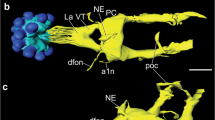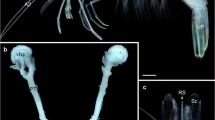Summary
The organization of the cerebral ganglion of the shore crab Carcinus maenas, is investigated by conventional histological and electronmicroscopic techniques. This study forms part of a comprehensive survey of the blood-brain interface, particularly interesting in this group, as decapod Crustacea are unusual among invertebrates in possessing an intracerebral blood supply. Apart from the intracerebral blood vessels, tissue organization is closely similar to that observed in insect central neural ganglia. The ganglion is surrounded by the neural lamella, an acellular connective tissue sheath, probably containing mucopolysaccharide and collagen. A layer of specialised glia, the perineurium, immediately underlies the neural lamella, and appears to contribute to its formation. Large glia occupying a conspicuous cortical zone below the perineurium may be involved in glycogen metabolism and storage. Further morphologically distinct glial types are observed associated with neurones and blood vessels, but all neuroglia within the ganglion are probably of common origin. Neurone cell bodies are generally situated peripherally in groups, and send axons into neuropil (synaptic) areas in the ganglion core. Large lacunae in the cortical region and narrower 20 nm clefts deeper in the ganglion, constitute the interstitial space, and contain deposits of fibrillar material. Possible physiological implications are discussed.
Similar content being viewed by others
References
Abbott, N. J.: Absence of blood-brain barrier in a crustacean, Carcinus maenas L. Nature (Lond.) 225, 291–293 (1970).
—: The organization of the cerebral ganglion in the shore crab, Carcinus maenas. II. The relation of intracerebral blood vessels to other brain elements. Z. Zellforsch. 120, 401–419 (1971a).
- Uptake of ions and molecules by the cerebral ganglion of the shore crab, Carcinus maenas. (In preparation.)
- Efflux of 22Na from the cerebral ganglion of the shore crab, Carcinus maenas. (In preparation.)
Ashhurst, D. E.: The connective tissues of insects. Ann. Rev. Ent. 13, 45–74 (1968).
—, Richards, A. G.: A study of the changes occurring in the connective tissue associated with the central nervous system during the pupal stage of the wax moth Galleria mellonella L. J. Morph. 114, 225–236 (1964a).
—: The histochemistry of the connective tissue associated with the central nervous system of the pupa of the wax moth, Galleria mellonella L. J. Morph. 114, 237–246 (1964b).
Bailey, A. J.: The nature of collagen. In: Comprehensive biochemistry (ed. M. Florkin and E. H. Stotz), vol. 26 B, pp. 297–423. Amsterdam-London-New York: Elsevier Publ. Co. 1968.
Bethe, A.: Das Nervensystem von Carcinus maenas. Arch. mikr. Anat. 50, 460–546 (1897).
Brewer, D. B.: Polarized light microscopy in the study of the fine structure of the tissues. J. Anat. (Lond.) 103, 591 (1968).
Bullock, T. H., Horridge, G. A.: Structure and function in the nervous system of invertebrates. London: Freeman 1965.
Claus, C.: Zur Kenntniss der Kreislaufsorgane der Schizopoden und Decapoden. Arb. zool. Inst. Univ. Wein 5, 271–318 (1884).
Conn, H. J., Darrow, M. A. (eds.): Staining procedures. Geneva-New York: Biotech Publications 1947.
Daems, W. Th., Persijn, J. P.: Demonstration of PAS-positive material in electron microscopy with lead staining. Histochemie 3, 79–88 (1962).
Debaisieux, P.: Histologie et histogénèse chez Chirocephalus diaphanus Prév. Cellule 54, 253–294 (1952).
Edwards, G. A., Ruska, H., De Harven, E.: Electron microscopy of peripheral nerves and neuromuscular junctions in the wasp leg. J. biophys. biochem. Cytol. 4, 107–114 (1958).
—: The fine structure of a multiterminal innervation of an insect muscle. J. biophys. biochem. Cytol. 5, 241–244 (1959).
Grobben, K.: Die Bindesubstanzen von Argulus. Ein Beitrag zur Kenntnis der Bindesubstanz der Arthropoden. Arb. zool. Inst. Univ. Wein 19, 75–98 (1911).
Gupta, B. L.: Personal communication.
Heuser, J. E., Doggenweiler, C. F.: The fine structural organization of nerve fibers, sheaths, and glial cells in the prawn, Palaemonetes vulgaris. J. Cell Biol. 30, 381–403 (1966).
Kramer, H., Windrum, G. M.: Metachromasia after treating tissue sections with sulphuric acid. J. clin. Path. 6, 239–240 (1953).
—: Sulphonation techniques in histochemistry with special reference to metachromasia. J. Histochem. Cytochem. 2, 196–208 (1954).
Kuffler, S. W., Nicholls, J. G.: The physiology of neuroglial cells. Ergeb. Physiol. 57, 1–90 (1966).
Lane, N. J.: The thoracic ganglia of the grasshopper, Melanoplus differentialis: fine structure of the perineurium and neuroglia with special reference to the intracellular distribution of phosphatases. Z. Zellforsch. 86, 293–312 (1968).
Malzone, W. F., Collins, G. H., Cowden, R. R.: Neuroglial relationships in the thoracic ganglion of the fiddler crab, Uca. J. comp. Neurol. 127, 511–530 (1966).
Manton, I., Parke, M.: Observations on the fine structure of two species of Platymonas with special reference to flagellar scales and mode of origin of the theca. J. marine biol. Ass. 45, 743–754 (1965).
Marinozzi, V., Gautier, A.: Essais de cytochimie ultrastructurale. Du rôle de l'osmium réduit dans les “colorations” électroniques. C.R. Acad. Sci. (Paris) 253, 1180–1182 (1961).
Maser, M. D., Rice, R. V.: Biophysical and biochemical properties of earthworm-cuticle collagen. Biochim. biophys. Acta (Amst.) 63, 255–265 (1962).
—: Soluble earthworm cuticle collagen: a possible dimer of tropocollagen. J. Cell Biol. 18. 569–577 (1963).
Mowry, R. W., Millican, R. C.: A histochemical study of the distribution and fate of dextran in tissues of the mouse. Amer. J. Path. 29, 523–545 (1953).
Nathaniel, E. J. H., Pease, D. C.: Collagen and basement membrane formation by Schwann cells during nerve regeneration. J. Ultrastruct. Res. 9, 550–560 (1963).
Oschman, J. L.: Microtubules in the subepidermal glands of Convoluta roscoffensis. Trans-Amer. micr. Soc. 86, 159–162 (1967).
Pantin, C. F. A.: Notes on microscopical technique for zoologists. Cambridge: Cambridge University Press 1946.
Ramsay, J. A., Brown, R. H. J.: Simplified apparatus and procedure for freezing-point determinations upon small volumes of fluid. J. sci. Instrum. 32, 372–375 (1955).
Reynolds, E. S.: The use of lead citrate at high pH as an electron-opaque stain in electron microscopy. J. Cell Biol. 17, 208–213 (1963).
Sandeman, D. C.: The vascular circulation in the brain, optic lobes and thoracic ganglia of the crab Carcinus. Proc. roy. Soc. B 168, 82–90 (1967).
Sewell, M. T.: Lipo-protein cells in the blood of Carcinus maenas, and their cycle of activity correlated with the moult. Quart. J. micr. Sci. 96, 73–83 (1955).
Smith, D. S., Treherne, J. E.: Functional aspects of the organization of the insect nervous system. In: Advances in insect physiology (eds. J. W. L. Beament, J. E. Treherne, and V. B. Wigglesworth), vol. 1, pp. 401–484. New York-London: Academic Press 1963.
Treherne, J. E., Maddrell, S. H. P.: Membrane potentials in the central nervous system of a phytophagous insect, Carausius morosus. J. exp. Biol. 46, 413–421 (1967).
—, Moreton, R. B.: The environment and function of invertebrate nerve cells. Int. Rev. Cytol. 28, 45–88 (1970).
Van Harreveld, A., Khattab, F. I., Steiner, J.: Extracellular space in the central nervous system of the leech, Mooreobdella fervida. J. Neurobiol. 1, 23–40 (1969).
Wigglesworth, V. B.: Histology of the nervous system of an insect. II Central ganglia. Quart. J. micr. Sci. 100, 299–313 (1959).
Author information
Authors and Affiliations
Additional information
I wish to thank Dr. J. E. Treherne for much encouragement and advice, Dr. A. M. Mullinger and Dr. B. L. Gupta for help and discussion concerning the electron microscopy, and Professor E. G. Gray for reading the manuscript. This work was supported by an SRC Research Studentship.
Fig. 14 is reproduced from “Nature” by permission of Macmillan (Journals) Ltd.
Rights and permissions
About this article
Cite this article
Abbott, N.J. The organization of the cerebral ganglion in the shore crab, Carcinus maenas . Z. Zellforsch. 120, 386–400 (1971). https://doi.org/10.1007/BF00324899
Received:
Issue Date:
DOI: https://doi.org/10.1007/BF00324899




